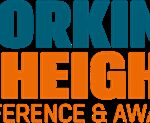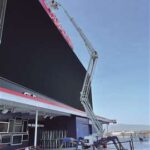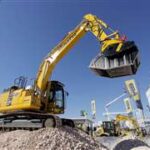Imagine trying to clean the windows on the 20th floor of a skyscraper, or fixing streetlights on a busy road. Without aerial work platforms (AWPs), these tasks would be almost impossible—or at least a lot more dangerous. From construction sites to maintenance operations, AWPs have revolutionized how we perform tasks at height, providing workers with the tools they need to work safely and efficiently. These versatile machines are no longer just a luxury for large companies; they’ve become essential for jobs that require elevated access.
What Exactly is an Aerial Work Platform?
An aerial work platform is a machine designed to provide temporary access to elevated areas, typically for maintenance or construction work. These platforms come in a variety of shapes and sizes, but they all share a common purpose: to safely lift people and their equipment to hard-to-reach places. Whether it’s a boom lift, scissor lift, or cherry picker, these devices offer mobility, stability, and precision, making them a better option than traditional ladders or scaffolding.
-
Boom Lifts (aka Cherry Pickers)
The cherry picker is perhaps the most iconic of all AWPs. Originally designed for picking fruit, it’s now used for a wide range of tasks, from fixing roofs and cleaning windows to installing lights and power lines. The key advantage of boom lifts is their flexibility. Their articulated design allows them to extend and maneuver in multiple directions, making it easier for workers to access awkward or hard-to-reach spots. This is why they’re so often seen on construction sites, in tree care, and in the entertainment industry for rigging lights and other equipment.In fact, the term “cherry picker” has become so synonymous with aerial work platforms that many people use it as a blanket term for all types of lifts, even though it originally referred to those designed for fruit picking. These machines are indispensable tools for anyone who needs to reach elevated work sites with precision.
-
Scissor Lifts
Unlike boom lifts, scissor lifts are designed for vertical movement only. They are ideal for jobs that don’t require the complex maneuvering of a boom lift but still demand elevated access. The mechanism that powers a scissor lift is relatively simple: it uses a crisscrossed pattern of linked supports, known as a pantograph, to extend the platform vertically. This simplicity makes scissor lifts easier to operate and maintain, while also making them more affordable than boom lifts.These lifts are commonly used indoors or on flat surfaces, such as for painting, electrical maintenance, or window cleaning. They’re often found in warehouses, retail stores, and airports where workers need to access high areas but don’t need to move the platform laterally.
Why AWPs Are a Game-Changer
AWPs do more than just lift people. They bring a whole new level of safety, efficiency, and precision to industries ranging from construction to maintenance. Before the advent of these platforms, workers had to rely on traditional ladders or scaffolding, both of which pose significant safety risks. Ladders, for example, are prone to tipping over, and scaffolding can take time to set up, making it inefficient for short-term tasks.
With AWPs, workers have a stable, secure platform that can be moved easily, even in tight or difficult-to-reach spots. They can also carry tools and equipment with them, reducing the need for climbing up and down a ladder or scaffold. This increases efficiency and minimizes the risk of accidents or injuries.
-
Safety First
The importance of safety cannot be overstated. AWPs are equipped with safety features that make working at heights less hazardous. For example, they often come with guardrails or safety harness attachment points to secure workers. Additionally, modern AWPs are designed with features like tilt sensors and overload indicators to prevent accidents caused by unstable conditions or excessive weight.Many platforms are also equipped with emergency lowering systems, which allow the operator to safely lower the platform in case of a power failure or malfunction. These built-in safety mechanisms ensure that AWPs are not just efficient, but also reliable and secure for workers.
-
Efficiency and Flexibility
AWPs provide unparalleled flexibility in the workplace. They can be easily repositioned, which is crucial for jobs that require access to multiple points of a structure. Unlike scaffolding, which requires assembly and disassembly, an AWP can be moved to the next location with minimal effort. This makes AWPs perfect for tasks that require mobility, such as electrical repairs, building maintenance, and tree trimming. Furthermore, many modern AWPs are self-propelled, meaning they can move around the job site without requiring external assistance. This reduces the amount of time needed to complete tasks and ensures that workers can stay focused on their work rather than spending time on setup.
AWP: More Than Just a Tool
One of the reasons AWPs are so effective is that they can be customized to meet specific needs. Beyond just providing access, many AWPs come equipped with additional features to aid in the completion of tasks. Some platforms have electrical outlets or compressed air connectors, allowing workers to power tools directly from the lift. Others may be fitted with specialized equipment, such as carrying frames for window glass or baskets for handling heavy loads.
In certain cases, AWPs are even adapted for specific industries. For example, underbridge units allow workers to safely access and repair the underside of bridges, while fire trucks often include aerial lifts to provide quick access to high-risk fire zones. The ability to adapt and customize AWPs makes them an indispensable tool for a wide range of industries.
Conclusion: The Future of AWPs
As technology continues to advance, the future of AWPs looks brighter than ever. We can expect to see even more innovative designs, improved safety features, and environmentally-friendly models. With the rise of electric and hybrid-powered AWPs, these machines are becoming more sustainable, especially for indoor or low-emission environments. The integration of smart technology will also allow AWPs to become more intuitive and easier to operate, potentially even self-diagnosing issues before they become problems.
Ultimately, aerial work platforms are more than just a convenience—they’re a necessity for anyone who needs to work at height. Whether it’s for routine maintenance, emergency repairs, or construction projects, these machines make tasks safer, quicker, and more efficient. And as technology progresses, the capabilities of AWPs will continue to expand, making them even more essential in the modern workforce.




